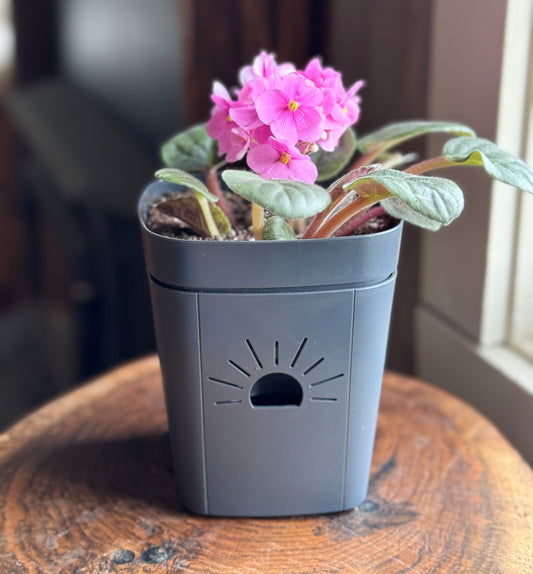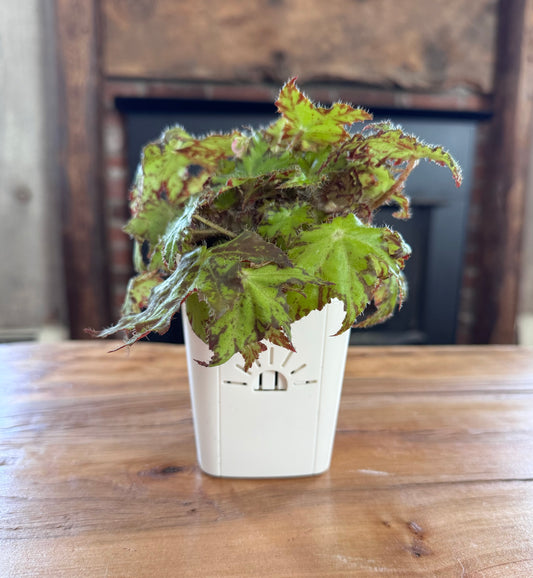Origins
The genus was first described by botanists in 1824. Codiaeum variegatum was described by the famous Swedish botanist Carl Linnaeus in 1753. Codiaeum is native to Malaysia, Indonesia, and Australia and also grows on a few Pacific Ocean Islands. They are shrubs with thick, leather-like leaves and are often mistaken for the genus Croton.
Light
Requirements
Codiaeum plants need plenty of light in order to produce their vibrant, multi-colored leaves. The best indoor light is about 24 inches away from a south-facing window (in the Northern hemisphere). They don’t like to be exposed to the full sun, however, as they naturally grow on the floors of the tropical forests of Southeast Asia. If you live in a place where the sun is too intense, use a sheer curtain to reduce the number of direct UV rays your plants receive during the hottest parts of the day.
Genus Summary
| GENUS | Codiaeum |
| COMMON NAMES | Croton |
| LIGHT | Very bright, indirect light |
| WATER SCHEDULE | Naked root 14-day schedule. |
| WATER REQUIREMENTS | Evenly damp but not soggy. |
| HUMIDITY | High Humidity |
| TEMPERATURE | 60-80°F. Never below 50°F. |
| FEEDING | 1x month |
| TOXICITY | Toxic to both humans and animals |
| PESTS | Spider mites |
| DISEASES | Edema |
| POT | Choose a pot that allows the soil to stay damp but not waterlogged while also letting oxygen reach the roots. |
| SOIL | Average potting mix, well-draining |
| FERTILIZER | 8-2-10 twice in spring |
| PROPAGATION | Stem Cuttings, air layering. Rarely root division |
| PRUNING | Only to remove dead plant matter |
| SIZE | 2’ to 8’ tall |
Water Requirements
Croton plants (C. variegatum) growing in a Naked Root planter are best watered on a 14-day schedule.
C. variegatum can be tricky to water in a traditional pot. The soil should be kept moist but not wet. Water the plant until liquid comes out of the bottom, and wait until the top layer of soil is dry before watering again. Avoid overwatering, which may cause wilting, or underwatering, which can cause dry or falling leaves. Keeping the soil consistently damp but not soggy is the key.
Humidity
Being tropical plants that grow on the forest floor in rainforests, C. variegatum loves high humidity.
Try setting your croton plant on top of a rock tray with water. Use pebbles or gravel and fill the saucer beneath the pot with water. This will help maintain humidity for your croton plant by evaporating slowly over time. Additionally, you could place the pot in a shallow tray filled with moistened horticultural charcoal, which works well to increase humidity levels around the plant.
If you’re raising it as a hanging planter, misting should be done every few days for the best results. However, make sure not to saturate its leaves as this may cause them to rot or become diseased from fungal infections caused by too much moisture.
Temperature
Temperature is important to C. variegatum. Most houseplants are pretty flexible when it comes to temperature, but crotons are not! At temperatures below 50°, they will experience pretty severe leaf drop.
If you’re growing a croton plant indoors, give them enough light with brighter spots near windows or under grow lights and keep the temperature between 60-80°F.
They can be grown outdoors, but keep them indoors when warm temperatures exceed 80° Fahrenheit or when temperatures drop below 55°.
Toxicity
Crotons possess a poisonous defense system that is toxic to both humans and animals, but they can still be kept as either indoor or outdoor decorative plants. Make sure to keep them away from children and animals and wear gloves when handling the plant, as the sap may cause skin irritation. Should the sap come into contact with your skin, wash off the area and apply a hydrocortisone cream. If someone ingests any part of the croton plant, seek medical help immediately.
Pests and Diseases
When growing Codiaeum plants, watch out for spider mites, which can cause yellow spots on the leaves and inhibit leaf growth. To get rid of them, wipe the leaves off with a damp cloth. Increasing the humidity may also help to prevent spider mites. Because crotons have such colorful leaves, spotting and webbing can be difficult to spot. This is one plant where a magnifying glass and a flashlight inspection are really useful.
If you are growing C. variegatum outdoors, Croton scale, mealybugs, thrips, and Croton caterpillars can show up for a snack.
There are also a few diseases to watch out for when growing C. variegatum indoors.
Edema, which appears as blisters on the leaves, is a sign that your Codiaeum plant is getting too much water. Lessen the frequency of watering until the blisters disappear, and make sure not to give it too much water. Keep the soil moist, though. When dealing with cut stems, be careful not to overwater, as this can lead to root rot.
Outdoor Codiaeum is susceptible to a bacteria called Crown gall (Agrobacterium tumefaciens). It causes growths on the leaves and stems and is hard to kill. Anthracnose is a fungal disease that grows on crotons grown outdoors. It appears as black patches on the leaves. There is a biological treatment called Bacillus subtilis that is very effective against Anthracnose. Lastly, powdery mildew is common in areas with overhead irrigation. When the leaves are regularly wet, this mildew develops. Neem oil will cure it quickly.
Pot
Choose a pot that keeps the soil evenly damp but allows for oxygen to reach the roots. Don’t plant a croton in a pot that is too big. Usually, a new pot only 1 or 2 inches bigger than the root ball is sufficient.
Soil
Croton plants are happiest in soil with good drainage, lots of organic material, and a pH level between 4.5-6.5. It is best to avoid soils that are high in pH or calcium content. Most store-bought potting soil should be suitable for growing C. variegatum.
When growing croton plants outside ,the best soil is an equal part sand, silt, and leaf compost.
Fertilizer
When it comes to caring for your croton plants, an 8-2-10 fertilizer mix is recommended, as they are particularly fond of potassium. This should be applied twice during the growing season, once in early spring (February/March) and again in late spring (May). A slow-release acidic fertilizer will ensure that the plant is well-fed throughout the summer. If you have a younger croton plant, you may need to give it an additional feeding around mid-summer. However, you should avoid fertilizing during fall, when the leaves start to mature and harden off before winter dormancy sets in.
Propagation
There are multiple methods to increase the number of croton plants.
Stem cuttings – Stem cuttings are the easiest propagation method for C. variegatum. To propagate, cut a part of the parent plant that has three or more leaves using a sharp, sterile pair of scissors. Strip off all but 3-5 leaves from the top of the stem. Then, either place it directly into a glass of water or dip it into a rooting hormone and place it in the soil. Place a bit of plastic over the container to trap humidity and stimulate root growth. Once roots have formed, you can safely transplant the cutting to a more permanent pot.
Air layering – A propagation method known as air layering can be used with a Croton plant. Make an angled cut on the stem while still attached to the main plant, then treat the wound with rooting hormone. Pack damp sphagnum moss around the area and keep it moist with plastic wrap. Over time, new growth roots will develop. Once this has happened, remove the plastic wrap and cut through the remaining stem. Place the new plant in a pot with good draining soil.
Root division – It is possible to separate a croton plant at the root if it has grown too large and the roots are visible through the drainage hole. However, this is not recommended, as C. variegatum does not like being moved around. The stress can cause wilting and leaf loss as a result. This method has about a 30 percent success rate, but if you are feeling adventurous, you can give it a try.
Pruning
Crotons usually only need to be pruned to get rid of dead or damaged foliage or to keep them small. Put on gloves when pruning this kind of plant, as its white sap can be irritating to the skin. Use a sharp, clean pair of bypass pruners or shears for the job. Cut off dead croton leaves and branches all the way down to the main body. If there is an infected branch, cut it off at least 6 inches outside of the infected area, above a leaf or node on the stem. To maintain shape, trim branches that are too long or overgrown above a leaf or node too. However, don’t remove more than a third of a branch’s length in order to avoid stressing out the Croton. Let it grow new leaves before pruning again.
10 Striking Varieties and Cultivars
C. variegatum ‘Gold Dust’ – This Codiaeum is a popular choice for landscaping and houseplant gardening because of its bright, green leaves that are splattered with yellow paint. Its oval-shaped leaves have a glossy finish, resembling wax. Gold Star is a similar variety, but its leaves are a bit more narrow in shape.
C. variegatum ‘Mammy’ – The Mammy cultivar is spectacular, as its contorted, multi-colored leaves look like streamers bursting out of its container. When grown indoors, the Codiaeum’s leaves are usually more muted in color, usually green and purple with some red. However, if exposed to bright light, the plant’s colors will become much more vivid and vibrant.
C. variegatum ‘Petra’ – The Petra variety of Croton is one of the most popular cultivars available. It features bold veining and edging in yellow, orange, and red. The leaves are oval-shaped with sharp points with stripes that look like a lace pattern. This vibrant plant is ideal for adding a touch of color to any living space!
C. variegatum’ Mother and Daughter’ – This interesting type of croton plant has distinctive, thin, strappy leaves with rounded tips. From the tip, a central vein grows. The vein is connected to a second leaf, which looks surprisingly like a quail head feather. It comes in various hues of green, orange, yellow, and purple, making it an attractive and visually appealing species of plant to keep!
C. variegatum ‘Red Iceton’ – One of the more show-stopping Codiaeum varieties is Red Iceton. Its oval-shaped leaves have a brilliant yellow hue when they first emerge, but as they age, they transition to pink and red tones. The colors are splotchy and dotted rather than striped along the leaf.
C. variegatum ‘Magnificent’ – The Magnificent Croton is like the Gold Dust croton in terms of the shape and spots on the leaves, but that’s where the resemblance stops. This particular type has a range of vibrant colors, such as pink, red, yellow, and orange, along with a hint of bronze and purple. The name truly says it all – it’s truly magnificent.
C. variegatum ‘Oakleaf’ – This type of Croton is known for its oak leaf-like leaves, which come in a variety of colors ranging from orange, red, yellow, and golden bronze.
C. variegatum ‘Eleanor Roosevelt’ – Compared to other species of Croton, the Eleanor Roosevelt has thinner foliage with a base color of medium green. Its leaves are deep purple and lime green. Each leaf is speckled with hundreds of tiny yellow spots, making it look like an exotic tropical grass.
C. variegatum ‘Zanzibar’ – If you are a fan of ornamental grass, then you will love Zanzibar! This Croton has thin leaves that resemble blades of grass. They emerge from the center of the plant in gold, lime, purple, burgundy, yellow, and pink for a whole rainbow of blades 3-6 feet long!
C. variegatum ‘Spirale’ – Spirale has green, red, and yellow leaves that are narrow and grow in a twist. The corkscrew-shaped leaves are thin and strappy, and the colors are blotchy rather than striped. This is an older cultivar that grows in an upright fashion and can get up to 3 feet tall.
Summary of Croton Plant Care
C. variegatum (commonly called Croton) is a tropical plant that likes evenly moist soil, high humidity, and very bright, indirect light. It requires temperatures that never dip below 50° and will show signs of displeasure with dramatic leaf drop. Keep it happy, and it will reward you with many years of bright exotic foliage.





 Verified Buyer
Verified Buyer









